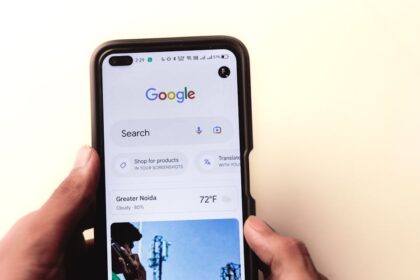The paradigm shift towards mobile-first engagement has fundamentally reshaped the digital landscape. What began as a mere supplement to desktop browsing has evolved into the primary, often exclusive, mode of internet access for billions worldwide. Google’s explicit shift to mobile-first indexing cemented this reality, moving beyond simply ensuring desktop content rendered adequately on smaller screens to demanding that the mobile version of a website be the definitive representation of its content and quality. This evolution mandates a departure from traditional SEO strategies, requiring a deep understanding of real-time, contextual, and intensely intent-driven mobile search behaviors. The future of mobile search is not just about responsiveness; it’s about anticipating user needs and delivering hyper-relevant experiences at micro-moments of inquiry, leveraging an array of emerging technologies that transcend the traditional text-based query.
The generative AI revolution stands as the single most transformative force impacting Search Engine Results Pages (SERPs). Large Language Models (LLMs) and conversational AI, exemplified by Google’s Search Generative Experience (SGE), fundamentally alter how users interact with information and how search engines deliver it. These sophisticated models move beyond simple keyword matching, instead processing complex, natural language queries to understand the underlying intent and synthesize comprehensive, conversational answers. This paradigm shift means users often receive direct, aggregated information at the top of the SERP, potentially reducing the need to click through to individual websites.
Implications for SEO strategy are profound. The era of pure keyword stuffing is unequivocally over, replaced by an imperative for semantic relevance and topical authority. SEOs must now optimize for the potential of content to be distilled into direct answers or featured snippets within AI summaries. The concept of “zero-click” searches, where users find their answers directly on the SERP without visiting a website, becomes a critical consideration. While this might seem detrimental to traditional traffic metrics, it underscores the heightened importance of brand presence and visibility within these AI-generated responses. Content creation must pivot towards comprehensiveness, accuracy, and undeniable authority, providing the depth and context that LLMs can draw upon to form their summarized answers. High-quality, well-structured, and semantically rich content becomes the foundational bedrock.
Data and trust are paramount in this AI-driven search ecosystem. The E-E-A-T (Experience, Expertise, Authoritativeness, Trustworthiness) framework, already a cornerstone of Google’s quality guidelines, gains even greater significance. For AI to reliably synthesize information, it must draw from sources that demonstrate verifiable E-E-A-T. This means website owners and content creators must rigorously focus on establishing their credibility, providing evidence of expertise, and ensuring factual accuracy. Fact-checking and clear source citation within AI-generated answers will become vital for user trust, as search engines increasingly attempt to combat misinformation. For SEO professionals, guiding clients to build and showcase strong E-E-A-T signals across their digital footprint is no longer just a best practice, but a critical survival strategy. This extends to author bylines, expert profiles, transparent business information, and fostering genuine user reviews and testimonials.
Voice search and conversational SEO represent the hands-free future, accelerating the trend toward natural language interactions. The proliferation of voice assistants across smartphones, smart speakers like Google Home and Amazon Echo, and increasingly integrated into in-car infotainment systems, makes optimizing for conversational queries non-negotiable. Understanding how Natural Language Processing (NLP) interprets spoken language, often characterized by longer, more complex phrases and question-based structures, is key.
Optimizing for voice search demands a shift from traditional short-tail keywords to long-tail keywords that mimic natural speech patterns. Content should be structured to directly answer common questions, making FAQ sections and Q&A formats invaluable. For instance, instead of optimizing for “pizza delivery,” the focus shifts to “where can I find a pizza place near me that delivers now?” This highlights the immense local SEO implications for “near me” voice queries, where proximity and immediacy are paramount. Implementing comprehensive schema markup becomes even more critical for voice search, as structured data provides clear, machine-readable interpretations of content, making it easier for voice assistants to extract precise answers. The rise of audio content, including podcasts and audio articles, also hints at new modalities of search consumption that SEOs will need to consider for discoverability.
Visual search and augmented reality (AR) are pushing search beyond text and voice, opening up entirely new dimensions of interaction. Visual search operates by allowing users to query information using images, leveraging advanced image recognition and object detection technologies. Platforms like Google Lens, Pinterest Lens, and Amazon StyleSnap exemplify this trend, enabling users to identify objects, find similar products, or learn more about what they see around them.
SEO for visual content therefore requires meticulous attention to image quality, descriptive alt text, and relevant filenames. Beyond basic image optimization, implementing structured data for specific content types like products, recipes, or articles with associated images becomes crucial. This enables rich snippets and enhanced visual search results on platforms like Google Images and Google Discover. Augmented Reality (AR) integration further extends the possibilities, offering “try before you buy” experiences for products, immersive navigation overlays in real-world environments, and interactive informational displays. This opens up potential for AR-specific search queries and experiences, requiring businesses to develop AR content that is not only engaging but also discoverable and optimized for these emerging interfaces. The ability to integrate product data with AR overlays could become a significant competitive advantage.
Hyper-personalization and contextual search are driving towards an individualized experience, moving away from a one-size-fits-all approach to search results. By leveraging vast amounts of user data—including location, browsing history, app usage, declared preferences, and even time of day—search engines are becoming increasingly adept at predicting user needs before a query is even fully articulated. This trend aligns perfectly with Google’s concept of “micro-moments” on mobile: “I want to know,” “I want to go,” “I want to do,” and “I want to buy.” Each micro-moment presents a unique opportunity for relevant content delivery.
For SEO, this necessitates a more nuanced focus on user intent rather than just broad keywords. Content strategy must consider dynamic content delivery, where information presented adapts based on the user’s specific context. Ethical considerations around data privacy and transparent personalization become paramount, as users demand more control over their data while still expecting highly relevant results. Brands that can deliver deeply personalized experiences while maintaining user trust will gain a significant edge in this evolving landscape.
Semantic search and knowledge graphs are the foundational technologies enabling this intelligent, contextual understanding. Moving beyond simple keyword matching, semantic search aims to comprehend the meaning and intent behind queries, recognizing entities, relationships, and concepts. Google’s Knowledge Graph, which powers Knowledge Panels and direct answers, exemplifies this by connecting disparate pieces of information to provide comprehensive, authoritative responses.
Structured data, primarily through Schema.org markup, serves as the backbone for semantic search. By explicitly labeling different types of content and their attributes (e.g., product price, article author, event date), businesses provide a machine-readable format that helps search engines understand the context and relationships within their data. This is crucial for unlocking rich snippets, enhanced SERP features, and for populating knowledge panels. Relevant schema types for mobile and AI search include Product, LocalBusiness, Article, FAQPage, HowTo, and VideoObject. Properly implemented schema bridges the gap between human language and machine understanding, ensuring that complex information is accurately interpreted and presented in an AI-driven search environment.
Core Web Vitals and technical mobile SEO are not just ranking factors; they are foundational elements of page experience and user satisfaction. Google has consistently emphasized that a positive user experience is critical, and poor performance directly impacts rankings. Core Web Vitals (CWV) provide quantifiable metrics for this experience:
- Largest Contentful Paint (LCP): Measures perceived loading speed by indicating when the largest content element on the page becomes visible. A fast LCP reassures users that the page is loading quickly.
- Interaction to Next Paint (INP): Replaced First Input Delay (FID) as the primary metric for interactivity and responsiveness. INP measures the time it takes for a user’s interaction (e.g., a click, tap, or keypress) to result in a visual update to the page. A low INP ensures a smooth and responsive user experience.
- Cumulative Layout Shift (CLS): Quantifies visual stability by measuring unexpected layout shifts during page loading. A low CLS prevents frustrating experiences where content jumps around, leading to accidental clicks.
Beyond CWV, several other technical factors remain critical. A mobile-friendly design, primarily achieved through responsive web design, ensures content adapts seamlessly to various screen sizes. While AMP (Accelerated Mobile Pages) has seen its role evolve, page speed optimization remains paramount, encompassing server response time, efficient image optimization (format, compression, lazy loading), and robust caching strategies. Mobile crawlability and indexability are fundamental; proper use of robots.txt, XML sitemaps, and canonical tags ensures search engines can discover and understand mobile content. HTTPS security is non-negotiable, protecting user data and contributing to trust signals. Finally, minimizing intrusive interstitials and pop-ups, especially on mobile, is crucial for maintaining a positive user experience and avoiding search engine penalties.
User experience (UX) and design are inextricably linked to mobile-first indexing, forming a symbiotic relationship with SEO. Mobile-first design principles prioritize usability, accessibility, and aesthetics for the small screen. This means intuitive navigation structures, clear calls to action (CTAs), and an information architecture that caters to on-the-go consumption. Content presentation should favor short paragraphs, bullet points, and the strategic use of multimedia (images, videos) to enhance scannability and engagement. Touch targets must be adequately sized and spaced to prevent mis-taps, and all interactive elements should be responsive. Accessibility (A11y) is no longer a niche concern; adhering to WCAG (Web Content Accessibility Guidelines) ensures that content is usable by individuals with disabilities, including compatibility with screen readers and other assistive technologies. A superior UX naturally leads to lower bounce rates, higher engagement, and improved conversion rates, all signals that search engines value and indirectly influence rankings.
Local SEO and geo-location services are gaining increasing prominence, particularly with the dominance of “near me” searches on mobile devices. Users frequently query for businesses, services, or products in their immediate vicinity, making optimization for proximity and convenience essential. Optimizing a Google Business Profile (GBP) is foundational, requiring accurate and complete information, regular updates, and proactive management of customer reviews and Q&A sections. Local citations across various online directories and consistent Name, Address, Phone (NAP) information are vital for establishing local credibility. Geo-fencing and location-based marketing, while not directly SEO, leverage geo-location services to target users with highly relevant content based on their physical presence. The emergence of local AI answers, where AI synthesizes information from various local sources (GBP, review sites, local news) to provide direct summaries, further emphasizes the need for comprehensive and accurate local data. For businesses with physical locations, a robust local SEO strategy is a direct path to capturing high-intent mobile search traffic.
App indexing and deep linking are critical for bridging the increasingly blurred lines between web and native app experiences. Mobile apps play a crucial role in user engagement and retention, often offering richer, more tailored functionalities than a mobile website. App indexing allows Google to crawl and index content within mobile apps, making it discoverable in mobile search results. Deep linking then takes this a step further, directing users not just to the app, but to specific content within the app, bypassing the need to navigate manually. This seamless transition enhances the user journey. App Store Optimization (ASO) complements traditional SEO efforts, focusing on keywords, reviews, and download volume within app stores, influencing app discoverability. The rise of Progressive Web Apps (PWAs) offers a compelling middle ground, combining the discoverability of the web with the native app features like offline access, push notifications, and home screen installation, further blurring the web-app distinction and offering new avenues for mobile content delivery and discoverability.
The expansion of the mobile search ecosystem extends to wearables and the Internet of Things (IoT). Smartwatches, fitness trackers, and emerging smart glasses represent new frontiers for search interaction. These devices often have limited screens and rely heavily on voice input and contextual cues, presenting unique challenges and opportunities for SEO. Ambient computing, where devices anticipate user needs and deliver information without explicit queries, is a nascent but rapidly evolving area. For example, a smartwatch could proactively suggest directions to a user’s next appointment based on their calendar and current location. SEO for IoT requires optimizing for data streams, ensuring information is readily available for integration points across various devices, and considering device-specific query patterns. This necessitates a fundamental shift in thinking from optimizing for web pages to optimizing for data and experiences across a distributed network of connected devices, often with unique constraints on how information is displayed and consumed.
New search interfaces and modalities are rapidly emerging, moving beyond the familiar smartphone screen. Smart displays and smart TVs, for instance, are becoming prevalent, focusing on visual answers, video content, and voice interaction. In-car infotainment systems offer navigation, local search, and hands-free voice commands, making automotive SEO a growing niche. The conceptualization of the Metaverse and mixed reality (MR) heralds a future of spatial computing, where search might occur within virtual or augmented environments, requiring optimization for 3D content, spatial relationships, and contextual overlays within these immersive digital worlds. Integrating SEO across these diverse platforms requires an adaptable strategy that considers the unique display capabilities, input methods, and user contexts of each device. Content must be flexible and modular, able to be delivered effectively regardless of the endpoint.
Ethical AI, data privacy, and evolving regulations are becoming central concerns in mobile search. With regulations like GDPR and CCPA setting precedents, user consent and transparent data collection practices are non-negotiable. SEOs and businesses must ensure their data handling complies with these complex and evolving privacy laws. Furthermore, the potential for bias in AI search algorithms is a critical ethical challenge. If training data is biased, the AI’s responses can perpetuate stereotypes or misinformation, undermining trust and equity. The importance of transparency and accountability in AI development and deployment is paramount. Maintaining user trust in a data-rich environment requires clear communication about data usage, robust security measures, and a commitment to fair and unbiased algorithmic outcomes. For SEO, this translates to working with development teams to ensure privacy by design and to prioritize user trust above all else.
Content strategy for the mobile-first, AI-driven future must undergo a significant transformation. The emphasis shifts from merely targeting keywords to establishing comprehensive topic authority. Instead of creating isolated articles, the focus moves towards building content clusters that thoroughly cover a subject, demonstrating deep expertise. The core objective of content becomes problem-solving and fulfilling diverse user intents, whether informational, transactional, or navigational. Multimedia content – video, audio, interactive infographics – is no longer optional; it is essential for mobile consumption, catering to varied learning styles and limited attention spans. Content must be concise, scannable, and actionable, designed for quick comprehension on small screens. Evergreen content, which remains relevant over time, combined with strategic content updates, ensures sustained visibility. Leveraging User-Generated Content (UGC) and reviews enhances credibility and provides fresh, authentic material. Fundamentally, the lines between marketing, SEO, and product development are blurring, necessitating integrated content strategies that serve both user experience and discoverability across all digital touchpoints.
Measurement and analytics for mobile SEO success require a sophisticated approach that transcends basic organic traffic metrics. Google Analytics 4 (GA4), with its event-driven data model, is better suited for understanding complex user journeys across multiple devices and touchpoints than its predecessor. Google Search Console (GSC) remains indispensable for monitoring mobile performance, indexing status, Core Web Vitals, and identifying crawling errors. Attribution models must evolve to accurately credit various touchpoints in a multi-device, multi-channel world, acknowledging the role of non-click interactions like direct answers or voice queries. Beyond traditional organic traffic, SEO success metrics should include visibility in AI summaries, brand mentions, direct answer appearances, and user engagement metrics like time on site for AI-driven traffic. Utilizing advanced tools for technical SEO audits, detailed rank tracking (including local and voice queries), and comprehensive competitor analysis will be crucial for navigating this increasingly complex landscape and demonstrating ROI.
The evolving role of E-E-A-T (Experience, Expertise, Authoritativeness, Trustworthiness) in mobile search is a constant reinforcement of its critical quality signal. In an environment where AI synthesizes information, the sources it draws from must be of the highest caliber. Demonstrating verifiable experience, expertise, authoritativeness, and trustworthiness becomes paramount for building brand reputation in an AI-dominated SERP. This involves meticulous author byline optimization, internal linking to expert profiles, and securing external citations from reputable sources. It’s about showcasing the human element and verifiable credibility amidst the proliferation of AI-generated content. For SEO professionals, guiding clients to build and showcase these signals across their digital footprint is not just a best practice; it’s a critical survival strategy.
Anticipated Google algorithm updates will continuously focus on user experience and content quality, with further integration of AI and machine learning at their core. We can expect more sophisticated algorithms capable of understanding nuances in intent and context. Potential shifts in indexing and ranking signals may emerge as AI becomes more central to search, prioritizing comprehensiveness and trustworthiness. The ongoing battle against spam and low-quality content will intensify, making it even harder for manipulative tactics to succeed. The increasing complexity of the ranking algorithm will demand deeper technical understanding and a more holistic approach to SEO that integrates various aspects of digital marketing and user experience.
The challenges and opportunities for businesses in the mobile SEO landscape are substantial. Challenges include the rapid pace of technological change, increased competition for diminished SERP real estate due to direct answers, and the difficulty of measuring ROI for zero-click searches. However, the opportunities are equally compelling: enhanced personalization capabilities, new interaction modalities like voice and visual search, deeper user engagement through immersive experiences, and a significant competitive advantage for early adopters. The overarching need for businesses is agility and continuous learning, adapting strategies quickly to leverage these shifts.
Navigating the mobile search ecosystem requires practical adaptations for SEO professionals. Cross-functional collaboration is no longer optional; bridging gaps between SEO, development, UX, and content teams is essential for cohesive strategy. Staying updated with regular monitoring of industry news and algorithm changes is paramount. Embracing experimentation, through A/B testing and pilot programs for new technologies, allows for learning and iteration. Finally, reframing success metrics beyond organic clicks to encompass comprehensive digital presence, including visibility in AI summaries, brand mentions, and overall user satisfaction, is crucial for building a future-proof mobile SEO strategy.











